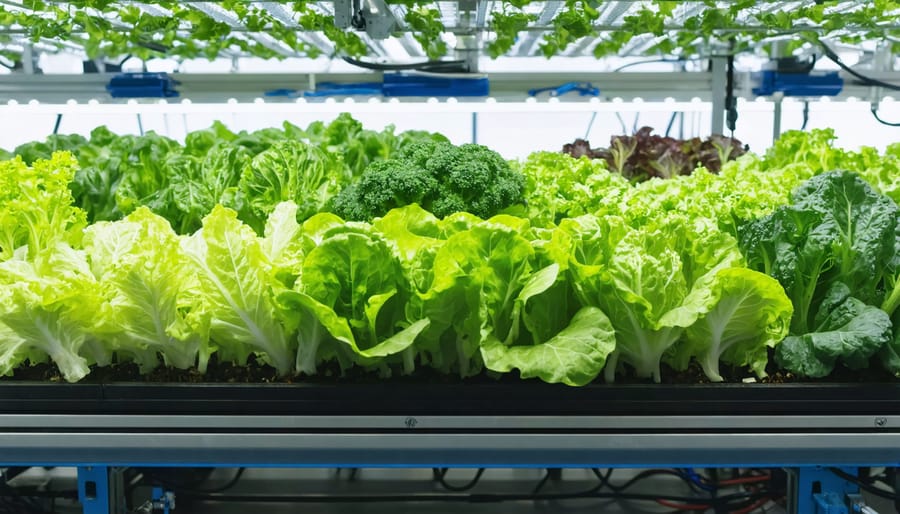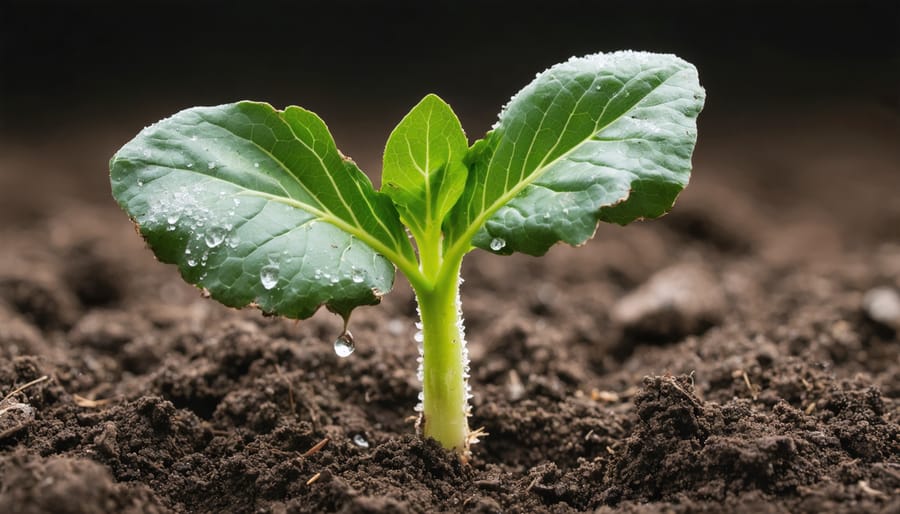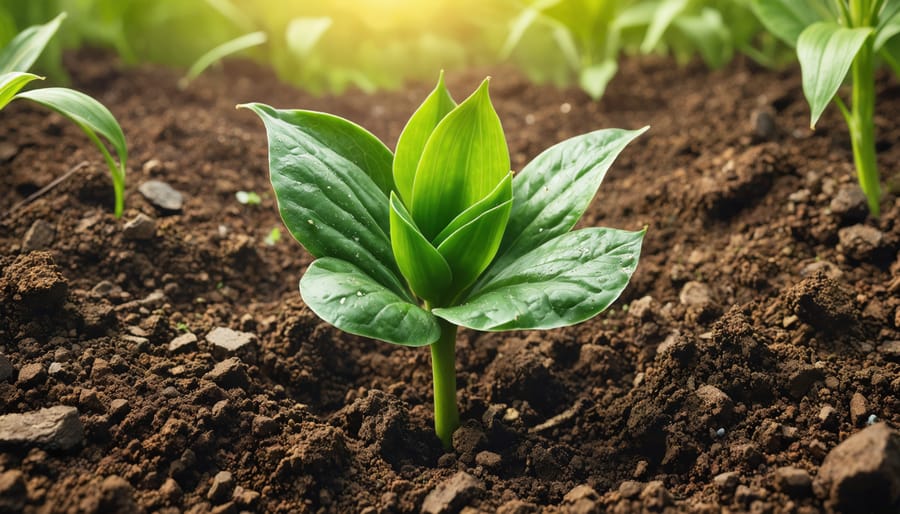Growing vegetables without soil revolutionizes modern gardening, offering solutions for limited spaces and water-scarce environments. Hydroponic and aquaponic systems produce up to 30% higher yields while using 90% less water than traditional methods, making them ideal for sustainable food production. These innovative water conservation techniques enable year-round growing regardless of climate conditions, transforming ordinary spaces into productive gardens.
From compact kitchen herb gardens to commercial-scale operations, water-grown vegetables thrive in controlled environments that maximize nutrient uptake and minimize resource waste. Leafy greens, tomatoes, and peppers flourish particularly well in water-based systems, offering fresher, cleaner produce without soil-borne diseases or pests. Whether you’re a curious beginner or an experienced gardener looking to expand your growing capabilities, water-based cultivation opens up exciting possibilities for sustainable, efficient food production right at home.
Water-Smart Growing Methods That Actually Work
Hydroponics: Growing Without Soil
Imagine growing fresh, crisp vegetables without a speck of soil in sight! That’s the magic of soil-free hydroponic solutions, where plants thrive in nutrient-rich water instead of traditional garden beds. This innovative growing method isn’t just a fascinating way to produce food – it’s also incredibly water-efficient, using up to 90% less water than conventional gardening.
In a hydroponic system, plant roots are suspended directly in water or supported by an inert medium like perlite or clay pellets. A carefully balanced mixture of nutrients feeds the plants, while oxygen pumps keep the roots healthy. The beauty of this system lies in its precision – you’re in complete control of what your plants receive, resulting in faster growth and higher yields.
What makes hydroponics particularly special is its closed-loop nature. Unlike traditional gardening where water drains away into the soil, hydroponic systems recirculate their water supply. This means every drop counts, and very little is wasted through evaporation or drainage. For home gardeners, this translates to lower water bills and a more sustainable approach to growing food.
Whether you’re working with limited space on a balcony or looking to maximize your indoor growing potential, hydroponics offers a practical solution for year-round vegetable production. From leafy greens to tomatoes and cucumbers, the possibilities are endless!
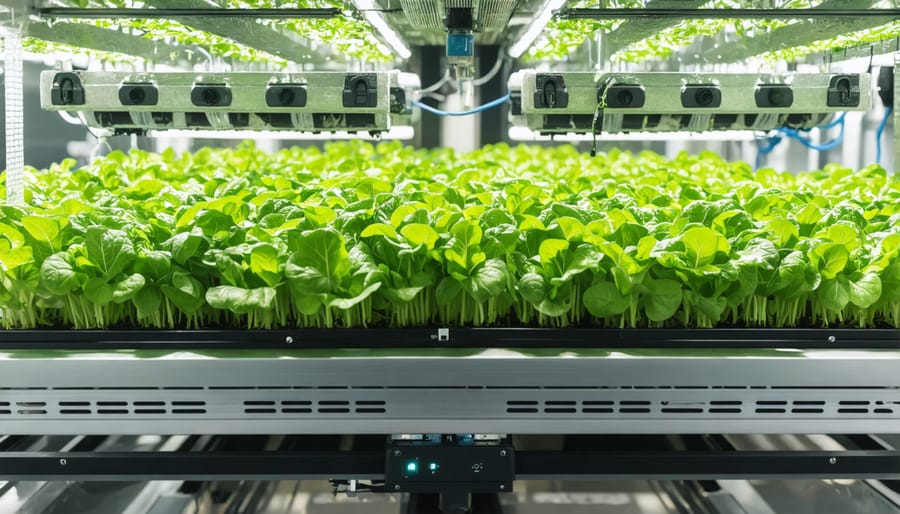
Deep Water Culture: The Floating Garden Method
Deep Water Culture (DWC) is one of the most efficient methods of growing vegetables in water, where plants float on a nutrient solution while their roots dangle directly into the water below. This system uses net pots filled with a growing medium like clay pellets or rock wool to support the plants, while an air pump provides oxygen to the roots through air stones.
What makes DWC systems particularly appealing is their simplicity and effectiveness. Plants in these systems typically grow faster and larger than their soil-grown counterparts because they have direct access to nutrients and oxygen. You’ll often see impressive results with leafy greens like lettuce, spinach, and herbs, which thrive in this environment.
Setting up a basic DWC system is surprisingly straightforward. You’ll need a container (like a 5-gallon bucket), a lid with holes for net pots, an air pump, air stones, and airline tubing. The nutrient solution stays relatively stable, requiring changes only every 1-2 weeks, making maintenance manageable for busy gardeners.
One of the greatest benefits of DWC is its water efficiency. While it might seem counterintuitive to grow plants in water to save water, these systems actually use up to 90% less water than traditional soil gardening because the water is constantly recirculated rather than lost to evaporation or drainage.
Temperature control and regular monitoring of pH and nutrient levels are essential for success, but once you get the hang of it, DWC can provide a steady supply of fresh vegetables year-round.
Best Vegetables for Water-Wise Gardens
Leafy Greens: Your Water-Saving Superstar
When it comes to water-efficient growing, leafy greens are the true champions of the garden. These versatile vegetables not only require minimal water but also provide quick yields and multiple harvests throughout the growing season. Lettuce, spinach, and other salad greens have shallow root systems that thrive in moist but not waterlogged conditions, making them perfect candidates for water-conscious gardening.
Lettuce varieties like Butterhead and Romaine are particularly well-suited for water-efficient growing methods. These varieties have adapted to make the most of limited water resources while still producing crisp, flavorful leaves. A simple drip irrigation system or even hand-watering with a gentle spray is all they need to flourish.
Spinach deserves special mention for its remarkable water efficiency. This nutrient-dense green requires just enough moisture to keep the soil from drying out completely, and it rewards careful water management with continuous harvests. Many experienced gardeners have found that spinach grown with controlled watering actually develops sweeter, more concentrated flavors.
Other water-saving superstars include arugula, Swiss chard, and kale. These hardy greens are masters at utilizing available moisture and can continue producing even during periods of reduced watering. The key is to maintain consistent but modest moisture levels and mulch around the plants to retain water in the soil.
For best results, consider growing your leafy greens in partial shade during hot summer months. This natural canopy reduces water evaporation and helps prevent the plants from bolting too quickly, extending your harvest period while keeping water usage to a minimum.
Root Vegetables and Herbs That Love Water Culture
While leafy greens are popular choices for water culture, several root vegetables and herbs thrive in this growing method too. Radishes adapt surprisingly well to water-based systems, producing crisp, flavorful roots in as little as 3-4 weeks. Turnips and small varieties of carrots can also flourish when given proper support and nutrients.
When it comes to growing herbs in water, you’ll find many varieties eager to establish strong root systems. Mint is particularly vigorous, often developing roots within days of being placed in water. Basil, oregano, and thyme also perform excellently, providing fresh herbs year-round while requiring minimal maintenance.
Sweet potatoes offer an interesting opportunity for water culture enthusiasts. While you won’t harvest traditional tubers, their vines produce edible leaves rich in nutrients. Plus, their trailing growth adds beautiful greenery to your growing space.
For best results with root vegetables, use deep containers that allow roots to develop fully. A solution depth of at least 8 inches works well for most varieties. Remember to maintain proper nutrient levels and monitor water temperature – root vegetables prefer slightly cooler conditions between 65-70°F (18-21°C).
Start with just one or two varieties to gain confidence, then expand your selection as you become more comfortable with the growing process. The key is providing adequate support for heavier plants and ensuring good aeration around the root zone. With proper care, these water-grown vegetables can yield impressive harvests while using significantly less water than traditional soil-based methods.
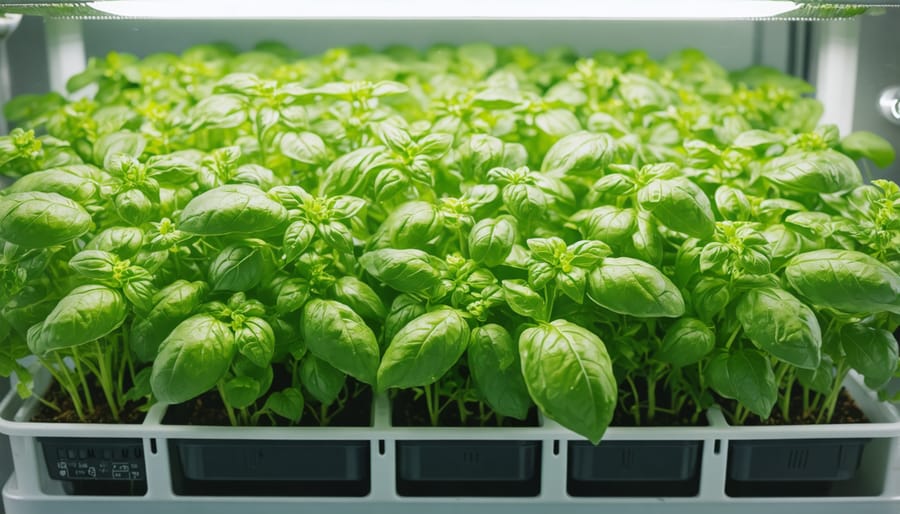
Setting Up Your First Water-Grown Garden
Essential Equipment and Materials
To get started with water-grown vegetables, you’ll need several essential items that create the perfect environment for your plants to thrive. First, you’ll need appropriate containers or growing systems – these can range from simple mason jars for small herbs to larger hydroponic setups. Look for containers that are food-safe and opaque to prevent algae growth.
A good quality growing medium is crucial. While soil isn’t needed, you’ll want to use either expanded clay pellets, rockwool cubes, or coconut coir to support your plants’ roots. These materials provide stability while allowing excellent water flow and oxygen reach.
For nutrients, invest in a water-soluble hydroponic fertilizer that contains all essential minerals. You’ll also need a pH testing kit and adjusters to maintain the optimal water conditions for your plants.
Some form of aeration system is vital – this could be as simple as an aquarium air pump with air stones for smaller setups, or more sophisticated pumps for larger systems. Don’t forget basic gardening tools like pruning shears, measuring cups, and plant supports.
Lighting is important if you’re growing indoors. LED grow lights are energy-efficient and provide the right spectrum for plant growth. Finally, keep a supply of fresh water on hand – filtered or dechlorinated tap water works best for most water-grown vegetables.
Remember to start small and add equipment as you gain experience. Many gardeners begin with just a few basic supplies and expand their setup over time.
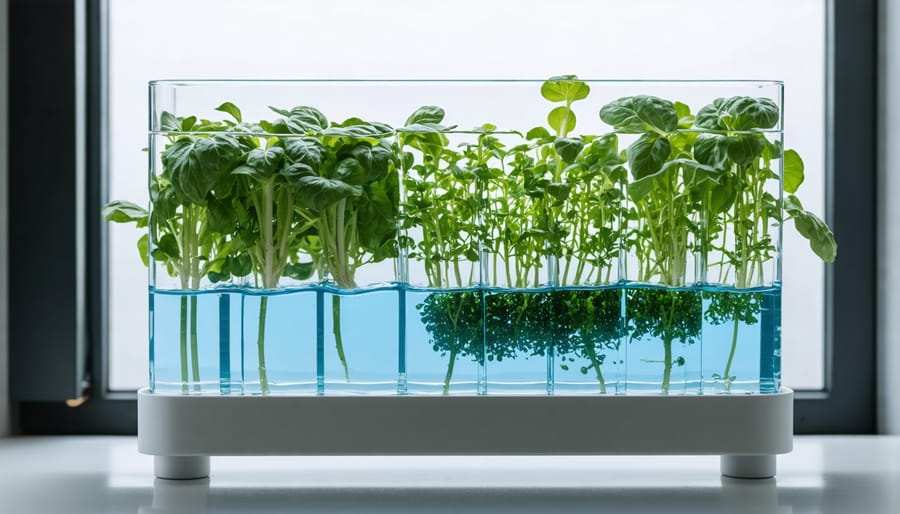
Maintaining Water Quality
Maintaining pristine water quality is crucial for the success of your water-grown vegetables. Regular monitoring and proper hydroponic nutrient management are the cornerstones of a thriving water garden. Start by testing your water’s pH levels weekly, aiming for a range between 5.8 and 6.5, which allows most vegetables to absorb nutrients efficiently.
Keep an eye on water temperature, maintaining it between 65-75°F (18-24°C) for optimal growth. Installing a simple aquarium thermometer can help you monitor this easily. Remember to change your water every 2-3 weeks, or sooner if you notice any cloudiness or unusual odors.
A reliable filtration system is your best friend in maintaining water quality. Consider using both mechanical and biological filters to remove debris and maintain beneficial bacteria. Adding an air stone or pump will ensure proper oxygen levels, preventing root rot and promoting healthy growth.
When adding nutrients, always follow the manufacturer’s guidelines carefully. Start with half-strength solutions for young plants and adjust based on their response. Keep detailed records of your water changes and nutrient additions – this will help you spot patterns and optimize your system over time.
Testing for electrical conductivity (EC) helps monitor nutrient levels, ensuring your plants receive the right amount of minerals without risk of burning or deficiency. If you’re new to water gardening, start simple and gradually build your expertise as you become more comfortable with the basics.
Troubleshooting Common Issues
Even the most dedicated water gardeners encounter challenges, but most common issues have straightforward solutions. If you notice yellowing leaves on your plants, this typically indicates a nutrient deficiency. Simply adjust your nutrient solution strength or check that your pH levels are between 5.5 and 6.5 for optimal nutrient absorption.
Algae growth is another frequent concern. To combat this, ensure your growing containers aren’t exposed to direct sunlight and consider adding an air stone to increase oxygen levels. If algae persists, a quick cleaning with a diluted hydrogen peroxide solution can help without harming your plants.
Root rot often occurs when water isn’t properly aerated or circulated. Install a small pump to keep water moving, and trim any brown or mushy roots immediately to prevent spread. If you spot wilting despite adequate water levels, check your water temperature – most vegetables prefer temperatures between 65-75°F (18-24°C).
Pest problems might seem unlikely in water systems, but insects can still appear. Natural solutions like neem oil or introducing beneficial insects can help maintain balance without harsh chemicals. For unstable or leaning plants, strengthen your support system using soft plant ties or adjustable clips.
Remember, prevention is often easier than cure. Regular monitoring of water quality, nutrient levels, and plant health will help you catch potential issues before they become serious problems.
As we’ve explored throughout this article, growing vegetables using water-efficient methods isn’t just a trend – it’s a sustainable solution that brings multiple benefits to both your garden and the environment. By adopting these water-conscious growing techniques, you can enjoy fresh, homegrown produce while significantly reducing your water consumption.
The advantages are truly remarkable: reduced water bills, fewer weeds to manage, and better control over your plants’ growing conditions. Many gardeners report that their water-grown vegetables taste better and grow more consistently than traditional soil-grown produce. Plus, these methods often result in higher yields in smaller spaces, making them perfect for urban gardeners or those with limited growing areas.
Remember, you don’t need to transform your entire garden overnight. Start small with a few simple systems, perhaps growing lettuce or herbs in a basic hydroponic setup. As your confidence grows, you can expand your water-efficient garden to include more varieties and advanced growing methods.
The initial investment in equipment and time will pay off through reduced water usage, lower maintenance needs, and abundant harvests throughout the growing season. Many gardeners find that their water-grown vegetables produce for longer periods than traditional gardens, offering extended harvest times and better value for their efforts.
Whether you’re motivated by environmental concerns, interested in maximizing your growing space, or simply looking for more efficient ways to garden, water-grown vegetables offer an exciting and rewarding path forward. The techniques we’ve discussed are accessible to everyone, regardless of experience level, and can be adapted to suit your specific needs and circumstances.
Take that first step today. Start planning your water-efficient garden, gather your materials, and join the growing community of gardeners who are embracing these innovative growing methods. Your future self will thank you as you harvest fresh, sustainable produce from your own water-smart garden.
Together, we can grow more while using less water, creating a more sustainable future for home gardening. Happy growing!

